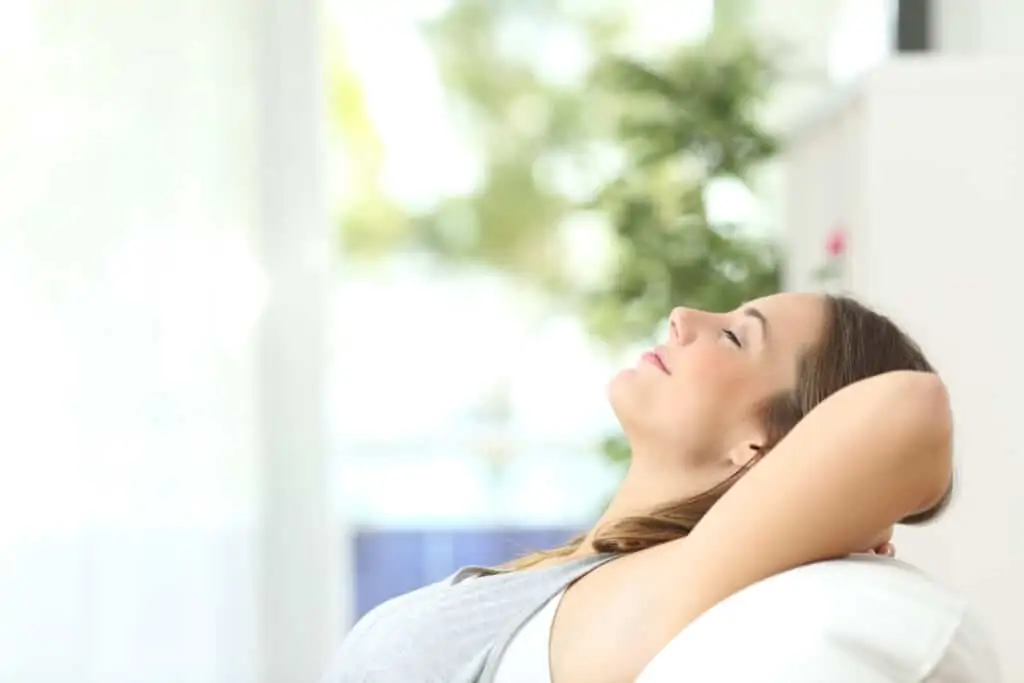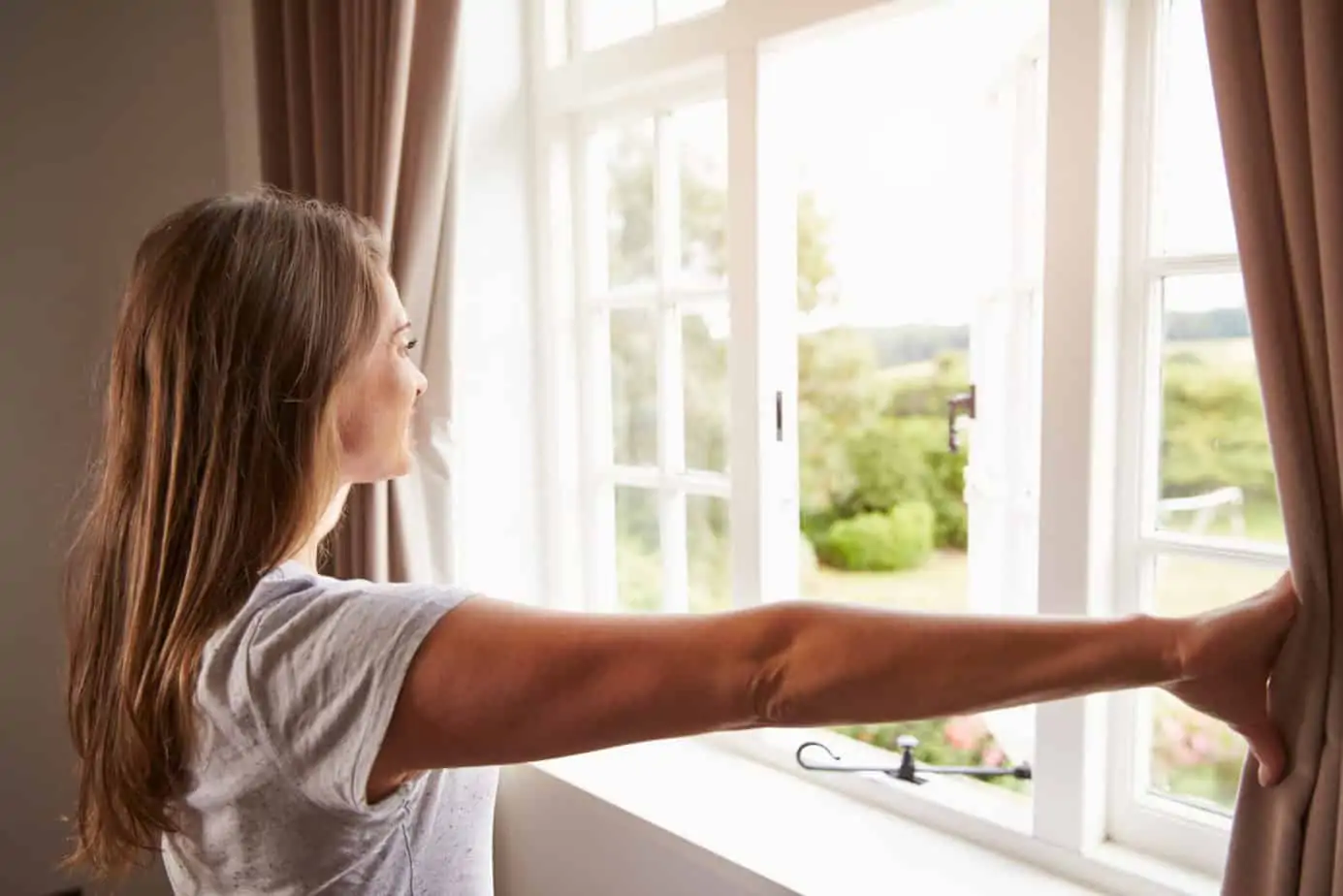Living with parenting anxiety is no way to live. Grounding techniques help you handle your parenting anxiety and stress that can be more helpful for immediate relief than medication. Put your parenting worries to rest. Battling anxiety as a mom can be lonely and overwhelming, but it’s not permanent.

Living with Anxiety Doesn’t Have to be Permanent
When my twins were born, I had what I’d call your average run-of-the-mill parenting anxiety.
I’d check to make sure they were breathing by putting my fingers near their nose, waiting to feel warm air. Or I’d stare at their tiny chest to make sure it was moving up and down when they slept.
As they got older, I’d cut grapes in fourths, and the rest of their food into tiny cubes so they wouldn’t choke.
I still slather them in non-toxic sunscreen and use safe plant-based cleaners.
Somewhere along the way though, my anxiety took a wrong turn and became something MORE.
It turned my everyday simple worries into dooms-day thoughts.
…. Heart pain? I must be having a heart attack.
…. My toddler’s growing pains at 2:03 am. It could be cancer.
…. A runny nose. Most definitely a life-threatening illness.
…. My 1st grader asked to take a nap. Oh no, what’s wrong?
…. 103 temperature. This is it. This IS the end.
I know everyone’s experience with anxiety is different and unique to the person. But, for me, anxiety starts small.
It’s sneaky like that.
One thought can wipe out my best day.
In five or ten minutes, when I let my guard down on my thoughts, it notices I’m not watching and plants the seed.
Very suddenly, one bad thought makes me feel out of control.
It’s like drifting down a peaceful stream and coming around a bend, suddenly being whipped around in Class V rapids.
The pit in my stomach doesn’t go away, even when the rationale part of my brain says, “No, I’m pretty sure everything is OK,” or “You’re Ok. Nothing bad is going to happen. It’s all OK.”
My heart races for hours.
You can probably see it beating from three feet away.
I can’t rest.
I can’t sleep.
I can’t function.
My mind won’t stop racing.
It’s debilitating.
It feels like my brain has 7,000 apps open, and 6,999 are going haywire.
The truth is, anxiety feels awful.
It makes you feel hopeless, like you’re drowning and can’t kick to the surface.
It makes you feel like you’re going crazy and wonder how much longer you can hold on.
The only thing you want, the one thing you’d give anything for, is for it to stop.
An Overactive Brain Makes Anxious Thoughts Worse
Anxiety can show up in different forms and isn’t always hyperventilating or scrubbing your home from top to bottom.
According to statistics, about 40 million Americans each year suffer from anxiety. Only about 31 percent of those people seek treatment.
Here are some ways anxiety attacks take different forms, such as:
- Unpredictable bouts of rage or irritability (angry, even yelling at your kids or spouse)
- Nit-pickiness (obsessive behavior) and even hyper-sensitivity to chaos, disarray, or change
- Obsessively cleaning and organizing
- Fast-talking, stuttering, and stumbling over words
- Not talking at all, closing ones self off
- Having feelings of insecurity, restlessness, feeling disconnected from yourself and surroundings
- Trouble concentrating
- Can’t sleep and inability to “shut off” your thoughts (monkey mind)
- Thoughts are caught on a loop
- Sitting rigid, starting into space, almost like you’ve “zoned out”
My anxiety used to show up when my house was messy.
The disarray would make me feel out of control and chaotic inside, so I’d go on a cleaning binge and my inside world would be nice and pretty again.
But, when I had a miscarriage, my anxiety worsened and began manifesting itself in a new way.
Suddenly, those thoughts of impending doom, had become real.
That’s when the floodgates broke open.
My body began to go in and out of “fight or flight mode” several times a day without any grizzly bear chasing me or flashing sirens going off.
My body would prepare for an attack and the only thing I could do was to sleep it off. Which, if you’re parent, isn’t optimal when you have little ones who depend on you.
I once had an anxiety episode last for two weeks and to say it was awful, is an understatement.
After that, I began seeking professional help to fight back against my anxiety.
The reason why it lasted so long?
I was trying to figure out WHY I was having such bad anxiety (my triggers) and tried to talk myself back to well and balanced.
This treatment doesn’t work.
It’s because the brain cannot handle any more new circuits and connections trying to be made when anxiety strikes.
Here’s why.
The brain has a million thoughts running around already. Making more thoughts trying to figure out your trigger and then rationalize with it, and when the brain is in hyperdrive, only magnifies and multiplies your thoughts.
That’s the wrong direction to take if you want to tame the beast.
What you really want to do is slow your brain down and put yourself in the moment.
You can do this by finding ways to shut down all the apps in your brain that are open, and give your brain clear directions to keep shrinking and shrinking down until it’s only processing one thought at a time.
The tricky part is that you can’t simply tell your brain to do this on it’s own because remember, your brain can’t hear you above the white noise when you ask it to do something.
However, it will be forced to refocus it’s attention when you take action.
Taking action is the key to combating your anxiety because it puts your brain in the moment, and takes you out of your mind and into the present.
Medical Note About Treating Anxiety: There can be medical reasons why you’re experiencing anxiety and panic attacks. I’m not a medical professional so I can’t speak to what may be going on with you. It’s always a good idea to talk with your doctor or reach out to a functional medical doctor or naturopath, who can run proper blood work and analyze your levels, hormones and organ functions for any supplemental needs or dietary changes that would help your overall wellbeing.
Finding Solutions to Ease Parenting Anxiety (& All Anxiety in General)
I knew when I started seeking solutions to anxiety, taking a pill prescribed by my doctor wasn’t a good fit for me. It may be for you and there is absolutely nothing wrong with this treatment plan. Personally, addiction runs in my family and pharmaceuticals are something I won’t touch.
I wanted to find natural solutions, and honestly, I needed to have tools to use if anxiety happened when I was at work, at home, with the kids, at the grocery store, on vacation… anywhere.
Grounding techniques for anxiety can be more helpful for immediate relief than medication.
After all, medication takes time to kick in and often time to find the right prescription to fit your body’s needs, but grounding techniques can help you immediately feel better.
Often a combination of grounding techniques like the ones I’ll teach you, relaxation techniques, and coping skills learned in therapy are the best combination for fighting anxiety.
These are the tools I’ve learned from my licensed therapist to FORCE my brain to slow down and stop my looping thoughts.
These tools have been really helpful in reducing the frequency of my anxiety attacks and shortening the length when they happen. I hope they help you too.
GROUNDING TECHNIQUES USING YOUR FIVE SENSES
When you practice grounding techniques, it helps you be mindfully aware of what is happening right now at the moment and bringing your awareness to the world around you.
Being in the present is what can make you feel grounded, or connected, and get outside of the thoughts looping in your head.
One of the most common grounding techniques for anxiety is to use the five senses technique.
In this exercise, you identify things that you can sense with your five senses. It helps your brain block out all the noise and puts you in awareness of your surroundings and can make you feel more connected and in the present.
Use your five sense to take in your surroundings by capturing as much detail as you with each of your five senses, for example:
- Sight: I see a blue house, green grass, white car, sidewalk, black crows, blue sky and white clouds, a car driving down the street, picture of my family on the wall, wind blowing the trees, the dogs running in the backyard, my kids playing baseball, etc.
- Smell: I can smell flowers, the sunscreen I put on this morning, my wet dog, dinner cooking in the kitchen, my kid’s stinky shoes, my husband’s aftershave, lotion, a candle, etc.
- Hear: I hear birds chirping, the clock ticking, typing on the computer, a tv playing a commercial, my dog breathing loudly, feet walking on the floor, a basketball being dribbled, etc.
- Taste: I taste the toothpaste I used this morning, the gum I’m chewing, the lunch I ate, etc.
- Touch: I feel the grass under my feet, holding my child and their soft skin and silky hair while I hold them, my dog’s wet noise, the table under my arms, the keyword I’m typing on, the soft seat I’m sitting on, my tongue wiping my teeth, the carpet under my toes is soft, the remote in my hand, the warm coffee mug I’m holding, etc.
When I go through my senses, I like to say them aloud too because I feel like it helps to ground me even more than silently thinking it.
By the time you have gone through all five of the senses, your mind should be away from whatever was making you anxious, and you should be mindfully in the present. If you still feel any twinge of anxiousness, repeat the grounding technique again to help you slow down even more.
Often, when I feel even the slightest onset of nervousness or anxiousness, I’ll go through the five senses grounding technique to help me be fully present.
BREATHING FOR CALM
We may tell our kids to “take a deep breath” or “catch your breath,” to calm down, and it’s a helpful tool… but what most of are don’t know is how to breathe correctly to calm down.
Inadvertently, we may be amping up our emotions if we take a long deep breathe and hold it.
(If you have kids, take note of this technique if you deal with tantrums and power struggles.)
Taking a deep breathe in and holding it actually energizes and stimulates the body.
Think about when you’re tired and your body lets out a big yawn.
It’s a long suck-in of air, then your body holds it and when you release it’s quick. Then, after you’ve finishing yawning, you feel a little burst of energy right?
When you’re experiencing anxiety, this is the exact opposite of what your body needs.
How can you breathe to calm down?
To calm down, you should take in a deep breathe, don’t hold it more than a second or two, but double the time it takes to gradually release the air.
Instead of spiking your oxygen and giving your brain a burst of energy, you’re doing the opposite and helping your body relax and feel calmer.
You can use your hand to help you visualize your breathe with this technique.
- Spread your fingers on your right hand.
- Starting with your thumb, as you take a breathe in, run your index finger from the opposite hand up the first finger at a normal speed.
- When it gets to the top of the finger, hold the breathe for a second.
- Then, very slowly, move your index finger down the thumb while releasing the air until you reach the base of the thumb finger. This should take twice as long as it took to move up the finger
- Repeat this breathing technique going up each finger at normal speed, stopping for a second at the top and going very slowly down the finger until you’ve gone up and down each digit.
FIND ONE THING YOU CAN ALWAYS TURN TO FOR A RELEASE
When you google anxiety relief, a lot of articles promote meditating and using calming mantras to help you quiet your monkey mind.
The problem is you want to get out of your head to turn off the constant chatter, which means you need to take action, not negotiate or talk-down the problem.
We already know that doesn’t work.
Since I was a child, water has always been my safe place.
Growing up in California, I was a water baby from the start and spent most of my childhood at the beach, playing at the lake, swimming in the pool or taking bubble baths.
Guess what?
Water is still a relief practice for me to this day.
- I’ll stick my feet in a warm foot bath for 20 minutes. My foot bath also has a massager at the bottom I can roll my feet on. Not only does it help to release tension, it takes my mind off the running thought inside my head and directs it to the sensation of my feet being massaged.
- I take a hot bath, mixing in epsom salts and lavender or another calming essential oil for 20 minutes to decompress. I may even watch a show or listen to a podcast on my phone nearby while I’m soaking.
- Head to the gym to get in an hour of swimming. Not only does exercise release feel-good hormones and releases the pent up cortisol, but the focus of being coordinated in the water, timing your strokes to the wall and breathing refocuses your mind.
Ask yourself, what is something that always helps you get your mind off things?
Here are some ideas that may prompt you to create your own toolkit:
- Go for a walk or exercise (you’ll notice the tension begin to melt off after 10 – 15 minutes and the reframing begin!)
- Read a book.
- Call a friend or better yet, visit with a friend.
- Walk your dog.
- Watch a movie.
- Go play with your kids outside.
- Kick off your shoes, put your feet in the grass and sit in the sun to soak up vitamin D.
- Paint or do an art project. The rhythm of moving through the project will put your mind chatter to rest.
What have you consistently leaned on throughout the years to help you manage or relieve stress (aside from eating an entire tub of cookie dough?)
THE POSITIVE EFFECTS OF CONNECTING WITH OTHERS
Humans have a primitive need for connection. Community has always been a part of our lives, yet, with social media we often can mistake interactions on our devices for real connection.
It is not the same.
Social media and text messaging are not real connection.
Your body craves companionship without WiFi and has a primal need for face-to-face interactions.
In fact, there are more and more studies that have come out in the past five years with evidence that being a part of a community is a major contributing factor to overall wellbeing.
The positive effects of connecting with others, even if it’s going to chat with your neighbor or another parent at pick-up, feeling a part of your community and to others outside of your immediate family, helps to combat loneliness, social anxiety, and all that runs through your head.
If you need help cutting the technology cord, this is a helpful article to breaking up with your smartphone and putting distance between you and Instagram (or other devices and apps.)
IT’S OK TO CRY
When I’m anxious, I feel like a shaken champagne bottle about to burst from the pressure.
How do people release pressure?
They scream, cry, and yell because all the build-up pressure gets released FAST.
Often a good cry is all I need to open my gauge and release the pressure that’s making me feel like my insides are running on a treadmill.
Crying may not always come easily and that means I may need to turn on a movie I know will lead to a good cry, or look at pictures of my pup who recently passed away, but the release is instant and oh, so sweet.
Pop that cork and release the pressure for instant relief!
You Still Need to Figure Out Where Your Anxiety is Rooted
It’s great to have tools to help you fight back against anxiety, but unless you fix what’s causing you to have panic attacks, they’re not going to go away.
I’ve been to several doctors and am working with a therapist who specializes in anxiety related to PTSD from trauma – it’s called EMDR therapy.
The misconception is that trauma is related to abuse – sexual abuse and physical abuse primarily. This is simply not true.
The truth?
It doesn’t matter how small or large your trauma is.
It could be you had one event in childhood such as your parent said something hurtful that’s stuck with you or you were made fun of in school. It could be a time you choked on food, or fell while riding your bike down the hill.
No matter how insignificant you may think an incident was, and whether you remember it or not, your body has identified this as trauma and has NOT forgotten it.
Or it could be a major event such as surviving a house fire, a car accident or death of a parent or sibling.
Nothing is insignificant.
Some insurance companies will pay or partially-pay for counseling to help you with anxiety and panic attacks.
Do you want to keep dealing with anxiety attacks or do you want to release what’s inside of you and say goodbye to them?
You don’t have to wait for things.
I want to let you know that getting help is a sign of strength, not weakness.
Too many people with anxiety suffer needlessly. Anxiety is treatable.
With a therapist, you’ll learn coping skills, desensitize yourself so that triggers no longer work to set off your anxiety, and change your way of thinking and behaving to decrease or eliminate your anxiety.
More Ideas to Help with Parenting Anxiety & Stress:
- Mom Burnout: Strategies to Being a Happier Mom
- When Motherhood Leads to Postpartum Depression & Burnout: How to Dig Yourself Out of Darkness
- Mom Burnout: Strategies to Being a Happier Mom
- Instant Ways to Stop Being Overwhelmed by Motherhood
- It’s Time to Say Goodbye to This Bad Parenting Habit: Break Your Smartphone Addiction
Want even more?
Shop All Parenting Resources
Shop all of our parenting resources from self-regulation tools and managing big emotions to building self esteem and confidence. There are resources for all seasons of life!









